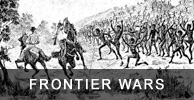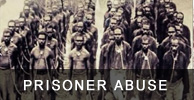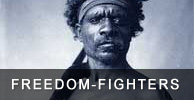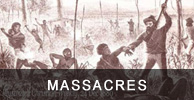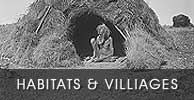The Freedom Fighters - Tunnerminnerwait and Maulboyheener
 Freedom Fighters Commemoration
Freedom Fighters CommemorationA Commemoration is held every year at midday on 20th January at the corner of Bowen & Franklin Streets, Melbourne to remember the freedom fighters Tunnerminnerwait and Maulboyheenner who were hanged for defending their lands and the genocide against their people - Contact Phone: 0439 395 489

Tunnerminnerwait aka Peevay, Jack of Cape Grim and Tunninerpareway. Born on Robbins Island in Tasmania in 1812, the son of Keeghernewboyheenner.

Truganini aka Trugernanna, Trugannini, Trucanini, Trucaninny and Lalla Rooke

Maulboyheenner aka Robert Smallboy, Jemmy, Timmy, Tinney Jimmy, Robert of Ben Lomond and Bob.
These images were published in James Fenton's History of Tasmania Hobart [1884]. The portraits above were painted by Thomas Bock between 1831 and 1835. Images and further details of the other two Freedom Fighters is not available. The images copyrights expired - Public Domain
 Tunnerminnerwait and Maulboyheener were the first two men to be (officially) executed in Melbourne on 20th January 1842. They were Indigenous freedom fighters who took up arms against the colonisers and paid the ultimate price for defending First Nations people against the invasion of their lands and the genocide of their people.
Tunnerminnerwait and Maulboyheener were the first two men to be (officially) executed in Melbourne on 20th January 1842. They were Indigenous freedom fighters who took up arms against the colonisers and paid the ultimate price for defending First Nations people against the invasion of their lands and the genocide of their people.
Tunnerminnerwait, Maulboyheener, Pyterruner, Truganini and Planobeena were among 16 Tasmanian Aborigines who were brought to Melbourne in 1839 by the protector of Aborigines, George Augustus Robinson., to "civilise" the Victorian Aborigines.
In late 1841, the two men and the three women, stole two guns and waged a guerilla-style campaign from the edge of the ranges east of Melbourne through to the southern end of Port Phillip.
They raided station after station from Dandenong to Cape Paterson. They stole firearms and burnt down stations, trying to avoid unnecessary deaths and gunfights. They killed 2 sealers, Cook and Yankee, wounded 5 settlers, burnt down numerous farm houses and evaded capture for 8 weeks.
Although they set out to drive the settlers from the bush, they didn't harm women or children and only fired at those that fired at them. Considering the outrages that had been perpetrated on them and their families in Tasmania, it's extraordinary that they didn't kill many more settlers when they had the opportunity to even up the score.
During the 8 weeks of their roaming, reports of their feats sent a shiver down the spine of the European invaders who were living in Melbourne and its surrounds and they launched three military expeditions against the Freedom Fighters.
Their capture was eventually effected by an overwhelming party of soldiers, police, settlers and black trackers near Anderson's Inlet, not far from Cape Patterson.
Tunnerminnerwait, Maulboyheener, Pyterruner, Truganini and Planobeena arrived in chains under military escort in Melbourne on 21st November 1841.
All 5 were charged with murder and appeared in court before Judge Willis on the 20th December 1841 with their defence counsel Redmond Barry, who questioned the legal basis of British authority over Aborigines.
The jury delivered a verdict after half an hour finding the men guilty of murder, and the women not guilty. The jury made a very strong plea for clemency for the men 'on account of general good character and the peculiar circumstances under which they are placed'.
The jury's plea for mercy was rejected by the Executive Council of New South Wales in the cases of the two men and Judge Willis sentenced the 2 men to death and the 3 women were acquitted and discharged into 'protector' Robinson's care.
On the 20th January 1842 the men were led to the scaffold on a small rise near what is now the corner of Bowen and Franklin streets, at the northern end of Melbourne city. They were hanged in front of 5000 people in a carnival atmosphere with many of the women dressed up in there finest clothes for the 'special occasion'. The crowd accounted for about a quarter of Victoria's white population at that time.
It was also reported that a group of First Nations people watched from the distance.
The bodies of the two male Freedom Fighters, Tunnerminnerwait, Maulboyheener, were then buried not far from their place of death, which is now Melbourne's 'Queen Victoria Market'.
Dr Joseph Toscano, anarchist and human rights campaigner, calls for a monument to the Freedom Fighters, Tunnerminnerwait and Maulboyheenner, who were the first judicial executions in Melbourne on January 20, 1842.
Jo wrote: 'Any visit to Canberra isn't complete without a visit to the National War Memorial. The massive driveway that leads to the Memorial is dotted with monuments to the Australian men and women who fought and died in wars Australia has been involved in. Around the country nearly every suburb, every town and every rural hamlet in Australia has an avenue of honour or monument to commemorate those who fought, those who were wounded and those Australians who paid the ultimate price, fighting wars stretching from the Boxer Rebellion in China, 1898, to Afghanistan in 2010'.
'Nowhere in the National War Memorial, nowhere among the thousands of monuments erected to Australians, who in the majority of cases died fighting other people's wars for the glory of God, Queen and Country, is a mention made of those original sovereigns who paid the ultimate price for protecting their families, their people, their way of life and their lands'.

